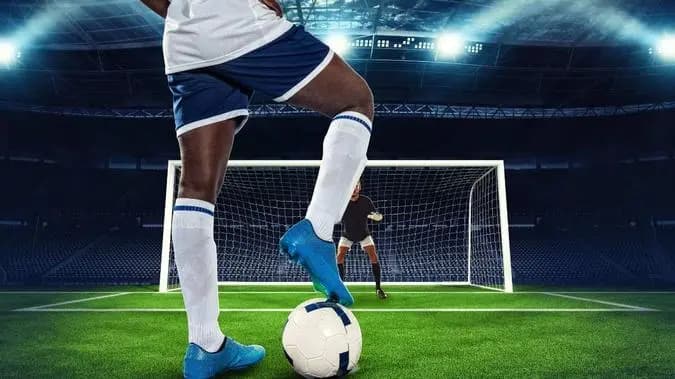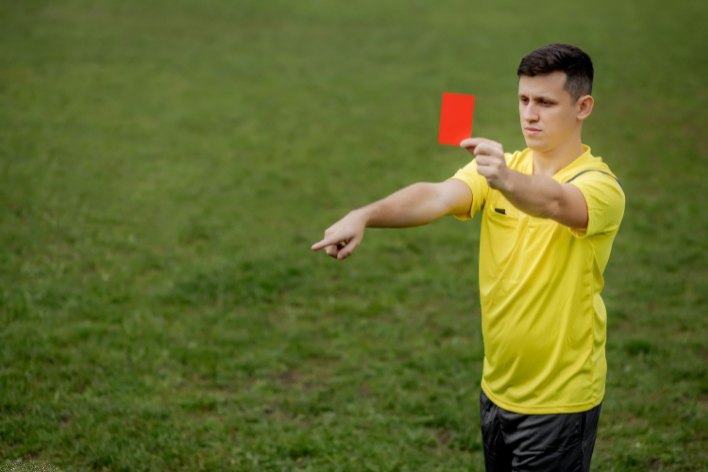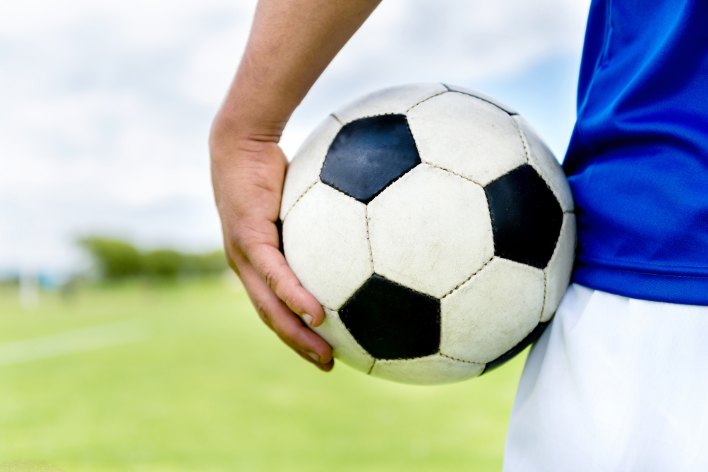Handball Rule in Football Explained
By Pinkey Sharma |
Date 22-08-2024

Table of Contents
- What Is the Handball Rule in Football?
- When Is a Handball Called?
- Types of Handball Offenses
- Evolution of the Handball Rule
- Major Rule Changes
- Role of the Goalkeeper in Handball Situations
- Famous Incidents of Handballs
- The Role of VAR (Video Assistant Referee) in Handball Decisions
- Introducing the Handball Rule to Youngsters
- Conclusion
- FAQs
Admissions Open for
Football is the most played game by millions of different age-derived populations across the globe. It is a game involving the kicking of the ball, making passes, and scoring goals. One thing a football player, except for a goalkeeper, is very much wary of is touching the ball using the hand at all costs. Now, this is where the handball rules in football matter.
The handball rule of football at times can become really tricky, especially for novices in the game. This blog, however, tries to break it down for you in the simplest and clearest fashion—everything you need to know about the Handball Rules football uses. This brings us back to the simplest question: what is the handball rule in football? By the end of this article, you will understand what the handball rules of football players are playing to and why it is so important to comply with them.
What Is the Handball Rule in Football?
This is the rule when players use their hands or arms in controlling, passing, or scoring goals. A player is said to have committed a handball offense if he does so, and a direct free kick or penalty kick will be awarded to the other team, depending on the field area where the handball was committed.
This rule is made to protect the integrity of the game and to make sure that football is played primarily with the feet like the sport is named. Save for goalkeepers who are allowed to use their hands, there are also areas attributed to them where they can handle the ball—the penalty area.
When Is a Handball Called?
To understand the handball rules as football uses them, knowing when the ball goes out should be judged. Not every time the ball hits a player's hand or arm is he called for a handball. Some key factors that guide the referee in making the decision include:
Was it a deliberate handball? Handball is when a player deliberately moves his or her hand or arm toward the ball to make contact.
Position of the Arm of the Player: The other important factor would be the position of the arm of the player. If the arm is in an unnatural position away from the body and makes contact with the ball, then the decision is most likely going to be a handball.
Distance: How far was the player from the ball when it came to be kicked? If the ball had been kicked from a very short distance, where there was no opportunity to move out of the way, then he would not have done so.
Goalscoring Situations: If on any occasion, a player scores with assistance from their hand or arm then that will always constitute handball and the goal will be disallowed.
Types of Handball Offenses
Handball rules of football, however, distinguish between various types of offenses. These may be categorized into varied situations depending on the scenario.
Intentional Handling: If an attacker handles the ball intentionally, then it is a free kick for the other team. This usually happens while one is trying to block either a pass or shot.
Accidental Handball: Even though this is an accidental handball, it can still award free kicks or penalties if it happens in specific situations, like a goal opportunity.
Handball in the D: When a defender handles the ball inside his area, the other team will benefit from a penalty shot—an opportunity that holds a great possibility of scoring a goal.
Handball by the Goalkeeper: A goalkeeper is allowed to use his hands, but only within his penalty area. When a handball occurs outside the area, this gives a free kick to the other team.

Evolution of the Handball Rule
Football changed and with this change its rules and those of handball followed suit. The rules of handball football used today have taken years to debate and perfect. It shall be intriguing to see how the rule has gone through time.
Football and Early Hand Usage
Football was mainly a hands-using game in its early days. The game traces its roots from the various games viewed as football and played in 19th England, which allowed handling of the ball. With the sports becoming organized and developed, development of formal rules and regulations, the need to further distinguish the game from other codes of football inclined towards rugby and others, the imposition of strict laws prohibiting the use of hands was necessary.
Introduction of the first rule of handball
Handball's very first recognized rule can be translated when the Football Association was organized in England in 1863. The current rule was that players should not "carry" with hands, except for employed goalkeepers. The rule then developed in the late century to forbid subtler ways players could unfairly obtain an edge in playing by handling the ball. Apparently, this is the ground for professional players in football to strictly follow for the better platform.
Major Rule Changes
These are some of the essential changes in the rule of the game handball in the 20th century, when a certain situation actually called for changing the rule of the game.
1920s: It is after this that the punishments for intentional handball offenses in the penalty area were introduced. This was just one huge change that involved only one very strict punishment against the defenders at their end of committing a handball offense.
1992: Goalkeepers were not allowed to handle back-passes from colleagues. This must have changed the game itself immensely only because this was an action against time-wasting and lack of skill.
2019: FIFA made a critical rule change that also specified what constituted an offense of handball, and it was more specific to situations where there had been a scoring of a goal. The rule gave importance to say that any goal scored directly from a handball use was inadmissible, whether it was intentional or not.
Role of the Goalkeeper in Handball Situations
Goalkeepers have an identity of their own when the issue of handball rules football enforces is brought to the fore. They are the only group of players that are legally allowed to use their hands, but then again, theirs is limited. Here is a look at goal-keepers and hand-ball rules highlight.
The Penalty Area Limitation
Goalkeepers are to handle the ball, but only under the condition of staying inside the penalty area. Handling of the ball outside this area by any player will attract a direct free kick to the opposing team. All these rules have remained the bone of contention that, particularly, goalkeepers are still not allowed to take advantage of using their hands out of their own area.
Probably, one of the most important rules that a keeper is to follow is a back-pass rule. This act does not allow a keeper to handle the ball when it is played from a teammate with their foot. In this foul act, the opposing team receives an indirect free kick from the point at which the keeper touched the ball. Mainly, this was developed to avoid civilizations, make the game sensory, and go.
Ball Handling Offense
After making a save, a goalkeeper is only permitted to hold onto the ball for a maximum of six seconds before riding it. This rule, in simple psychology, is meant for the continuity of the game without having to waste any time through a goalkeeper who decides to hold onto the ball for too long in the process of playing a match.
If the goalkeeper offsides in a handball offense outside the penalty area, the punishment will be like for any outfield player that would have handled a corresponding offense outside the area. More significantly, being the last and only line of defense, the same act by the goalie can assume enormous proportions and easily turn a potential goal-scoring opportunity for the opposing team.
Famous Incidents of Handballs
In the history of football, there has and continues to be a great incidence of handballs that brought about so much debate that it even led to rule changes.
Diego Maradona's "Hand of God" (1986): It is definitely one of the most famous acts in the history of handball when during the 1986 World Cup, Argentina's Diego Maradona scored using his hand. Because the referee did not notice the foul on the player, the goal was counted, and this would eventually make it one of the biggest controversies ever over the beautiful game.
Thierry Henry Handball on Ireland 2009: With this World Cup qualifying match running out of time, the French forward handled the ball before laying it off to a teammate who scored the winner, which for all intents and purposes eliminated Ireland. It caused an uproar because it directly impacted the result of the match, with several authorities calling for a change in how handball decisions are made.

The Role of VAR (Video Assistant Referee) in Handball Decisions
The application of VAR has had an impact on the decisions taken on the field of play concerning handballs in football. VAR is a technology that gives room for referees to review incidents so as to make a more accurate decision, though it caused numerous controversies, among others:.
Marginal Calls: The use of VAR in fact has meant that a few handball decisions have been given on such tiny margins as the ball just brushing against the hands of a player. It has put paid to raising the effective question whether rules need to be applied with some flexibility in interpretation.
Consistency in Decision-Making: One area where decisions seem to have improved with the arrival of VAR is handball. But there are still a few consternations that whether referees do apply an interpretative variation to officiating ever slightly, making consistencies remain at large.
Introducing the Handball Rule to Youngsters
Knowledge of the handball rules football requires is essential for young players when they are picked up for conte. Teaching such rules in simple and fun ways will help kids develop their skills to prevent repetitions of the same mistakes over and over again during matches.
By Using Visual Aids
Visual aids are likely to be the most effective way of teaching young players about the handball rule. Extensive use of infographics, videos, and animations should be put into place so that kids can see the difference between what is handball and what is not. Coaches can use these tools during practice sessions for a recap of the rules.
Examples of Visual Aids
Drawings: Simple pictures of the body position of a player and where the ball is able or not able to make touch with hands or arms. Do it in other colors and point out the ball and the player's arms to make it easier to see what is meant by the rules.
Videos: Play videos of either games or practice sessions with occurrences of the ball hitting a player's hand or arm. Explain each clearly to show the right way and the wrong way in handling the ball.
Animations: Either animated videos or interactive apps showing handball situations where kids can engage with the content in an active manner.
Penalty Area Scenarios
Defensive Positioning: Develop situations where defenders are requested to position their arms correctly to prevent handball offenses inside the penalty area. Use cones or markers to simulate play. Allow the players to become accustomed to keeping their arms in the right position.
Role-Playing: Allow the players to play penalty area scenarios as attackers and defenders. This will create an understanding for both roles of the handball decisions and what they mean, but also develop the player's skills in those roles.
Simple Explanations
When explaining the handball rules football follows, younger players describe it in simple terms. Avoid using complicated levels within the description, and always keep it concise and easy to understand.
Conclusion
The handball rules football abides by are a means to ensure justice and integrity in the play. When players, coaches, and fans respect these rules, they will begin to appreciate this complicated yet important rule—the handball rule.
Over time, the evolution of football will definitely change the handball rules that football enforces. Staying informed regarding these changes, all involved in the sport can adapt to them and continue enjoying the beautiful game. Whether you are a player learning the rules, a coach teaching young athletes, or even a fan following the game, understanding the handball rule clearly enhances one's appreciation of the football game.
FAQs
1. What is considered a handball according to handball rules football?
According to the handball rules football follows, a handball occurs when a player uses their hand or arm to touch the ball. This includes both intentional and unintentional contact. The key factors include whether the hand or arm is in an unnatural position and if the player gains an advantage from the contact. The handball rules football enforces do not apply to goalkeepers within their penalty area or if the ball strikes a player's hand accidentally while it is close to their body.
2. How does the referee determine if a handball is intentional under handball rules football?
Under the handball rules football follows, referees determine if a handball is intentional by considering factors such as the player’s arm position, movement, and proximity to the ball. An intentional handball often involves a deliberate action to control, block, or direct the ball with the hand or arm. If the arm is extended away from the body or if the player makes a clear movement towards the ball, it is more likely to be deemed intentional. Referees use their judgment, experience, and sometimes video assistance to make this decision in line with the handball rules football enforces.
3. If one player accidentally handled the ball, what would be the decision based on handball rules football?
In relation, according to the rules of handball that football enforces, in case a player handles the ball on purpose, the referee will look at the context under which this occurred. If the handball is not intentional and he does not get any advantage, he may not penalize. Nevertheless, if the accidental handball was to have an extraordinary effect on play, like preventing the development of a goal-scoring opportunity, then a free kick or penalty may be awarded to the opposing team. The football rules on handball consider the nature of the contact and its impact on the game.
Liked what you read? Feel free to share this article with your friends and spread the knowledge!
CBSE Schools In Popular Cities
- CBSE Schools in Bangalore
- CBSE Schools in Mumbai
- CBSE Schools in Pune
- CBSE Schools in Hyderabad
- CBSE Schools in Chennai
- CBSE Schools in Gurgaon
- CBSE Schools in Kolkata
- CBSE Schools in Indore
- CBSE Schools in Sonipat
- CBSE Schools in Delhi
- CBSE Schools in Rohtak
- CBSE Schools in Bhopal
- CBSE Schools in Aurangabad
- CBSE Schools in Jabalpur
- CBSE Schools in Jaipur
- CBSE Schools in Jodhpur
- CBSE Schools in Nagpur
- CBSE Schools in Ahmednagar
- CBSE School In Tumkur

Call Us to know more about Orchids
Swipe Up

















